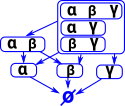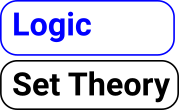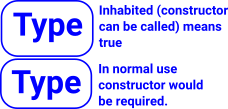Model Theory
All the flavours of model theory rest on one fundamental notion, and that is the notion of a formula φ being true under an interpretation I. (Wilfrid Hodges)
Theory
| In model theory a 'theory' is a set of first-order sentences, for instance: |
|
In this diagram we have a box for each set of these sentances: The arrows mean implies. A set with more sentances can imply a set with less sentances because we are using Intuitionistic logic so we don't use the excluded middle rule. So if a sentance is not included in a set it doesn't mean its false it just means we are not saying anything about it. I have left out arrows if they are given by composing the above arrows. |
 |
| There is more we can imply from these sentances because α and γ implies β so we can add the red arrows: |  |
| In a similar way we can imply α from β and γ. We can't however imply γ from β and α. |  |
| If there is an implication arrow going in both directions we can treat the sets as being the same. So here I have put them in the same box: |  |
Model of Theory
There can be multiple models of any given theory
Interpretation
The variables are given values which make the sentances true.
Define a structure B using structure A.
see internal language of a category on page here.
Proofs in Different Theories
We can look at proving things in different theories, such as,
- Set Theory
- Type Theory
- Topology
- Homotopy Type Theory
- Category Theory
In many areas, such as set theory, we use a logic over the theory. When proving things we usually use Intuitionistic logic (see page here). Although there is also a connection between set theory and boolean logic which can be seen nicely in Venn diagrams. |
 |
Logic and Type Theory
| 'It is useful to distinguish between the internal type theory of a category and the internal logic which sits on top of that type theory. The type theory is about constructing objects, while the logic is about constructing subobjects.' | see ncatlab |
 |
In type theory, types can represent both the structure and the logic within type theory. |
Logic and Category Theory
See topos theory
Equality
Equality
Equality
Next
A more axiomatic approach to model theory requires:




